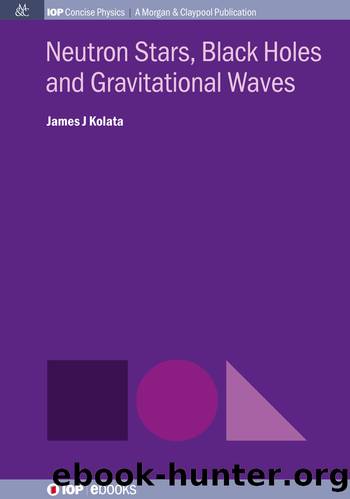Neutron Stars, Black Holes and Gravitational Waves by James J Kolata

Author:James J Kolata
Language: eng
Format: epub, mobi
ISBN: 9781643274225
Publisher: IOP Publishing
Published: 2019-04-06T00:00:00+00:00
The (Schwarzschild) radius of a black hole increases when matter falls into it to account for its greater mass. It also turns out that the âgravitational tidal effectsâ at the event horizon become weaker as the mass and radius of the black hole increases. To understand these tidal effects, think about the effect of gravity on your body as you stand on the surface of the Earth. Since gravity is slightly weaker at your head than at your feet, there is a very small net force tending to pull you apart. This effect is greatly magnified near a solar-mass black hole due to its much greater gravitational attraction, but it is smaller for a supermassive black hole due to its enormous size. This means that you could in principle cross the event horizon of a supermassive black hole, such as the one at the center of our galaxy, without immediately being torn apart by tidal forces, and you might in fact not even notice that you had actually passed the point of no return!
An interesting sidelight of falling into a supermassive black hole concerns the nature of this event as observed by you (as you fall into the black hole) and someone at a distance from the black hole. You would observe nothing special on crossing the event horizon, and it would take only a short while (as measured by your clocks) for you to fall into the âsingularityâ at its center. There is no way to avoid this. Once you cross the event horizon, you are doomed to be compressed into the singularity. However, because of âgravitational time dilationâ, an observer at a distance from the black hole would see you approach the event horizon but never cross it! This is one of the strange effects of the General Theory of Relativity.
The rotation rate of a black hole has a natural limit, when the event horizon is rotating at the speed of light. This means that the larger (i.e. more massive) the black hole, the slower its maximum rate of spin. It turns out that the event horizon of a non-rotating black hole is spherical, which prevents us from seeing the singularity at its center. This has become known as âcosmic censorshipâ. However, the event horizon of a rapidly spinning black hole is deformed and bulges at the equator (just like the Earth). This brings up the interesting question if the deformation could ever be great enough that we could directly observe the ânaked singularityâ at its center. This question has not been answered yet. It was the subject of a famous bet between Steven Hawking and Kip Thorne. The rotation of a black hole is interesting for another reason. A solution of Einsteinâs general relativity equations for this case (the âKerr solutionâ) reveals that the rotation of a black hole causes a âswirlingâ of spacetime outside of it, i.e. outside the event horizon. Because of this, it turns out to be possible to extract a really huge amount of rotational energy from a spinning black hole (thus slowing down its rate of spin).
Download
Neutron Stars, Black Holes and Gravitational Waves by James J Kolata.mobi
This site does not store any files on its server. We only index and link to content provided by other sites. Please contact the content providers to delete copyright contents if any and email us, we'll remove relevant links or contents immediately.
| Automotive | Engineering |
| Transportation |
Whiskies Galore by Ian Buxton(41720)
Introduction to Aircraft Design (Cambridge Aerospace Series) by John P. Fielding(33017)
Small Unmanned Fixed-wing Aircraft Design by Andrew J. Keane Andras Sobester James P. Scanlan & András Sóbester & James P. Scanlan(32685)
Craft Beer for the Homebrewer by Michael Agnew(18082)
Turbulence by E. J. Noyes(7895)
The Complete Stick Figure Physics Tutorials by Allen Sarah(7265)
Kaplan MCAT General Chemistry Review by Kaplan(6823)
The Thirst by Nesbo Jo(6759)
Bad Blood by John Carreyrou(6477)
Modelling of Convective Heat and Mass Transfer in Rotating Flows by Igor V. Shevchuk(6354)
Learning SQL by Alan Beaulieu(6159)
Weapons of Math Destruction by Cathy O'Neil(6085)
Man-made Catastrophes and Risk Information Concealment by Dmitry Chernov & Didier Sornette(5878)
Digital Minimalism by Cal Newport;(5588)
Life 3.0: Being Human in the Age of Artificial Intelligence by Tegmark Max(5405)
iGen by Jean M. Twenge(5326)
Secrets of Antigravity Propulsion: Tesla, UFOs, and Classified Aerospace Technology by Ph.D. Paul A. Laviolette(5237)
Design of Trajectory Optimization Approach for Space Maneuver Vehicle Skip Entry Problems by Runqi Chai & Al Savvaris & Antonios Tsourdos & Senchun Chai(4957)
Electronic Devices & Circuits by Jacob Millman & Christos C. Halkias(4866)
